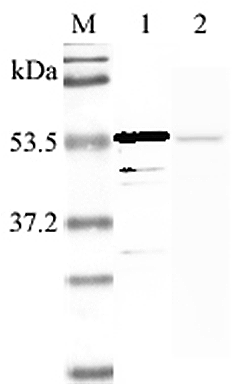anti-Nampt (Visfatin/PBEF) (human) pAb (Biotin)
| Code | Size | Price |
|---|
| AG-25A-0025B-C050 | 50 ug | £282.00 |
Quantity:
Prices exclude any Taxes / VAT
Overview
Host Type: Rabbit
Antibody Clonality: Polyclonal
Regulatory Status: RUO
Target Species: Human
Applications:
- Enzyme-Linked Immunosorbent Assay (ELISA)
- Immunohistochemistry (IHC)
- Western Blot (WB)
Shipping:
-20°C
Storage:
-20°C
Images
Documents
Further Information
Alternate Names/Synonyms:
Pre-B Cell Colony Enhancing Factor 1; PBEF1; Nicotinamide Phosphoribosyltransferase
Concentration:
1mg/ml
EClass:
32160000
Form (Short):
liquid
Formulation:
Liquid. 0.2µm-filtered solution in PBS, pH 7.4. Contains no preservatives.
Handling Advice:
After opening, prepare aliquots and store at -20°C.Avoid freeze/thaw cycles.
Immunogen:
Recombinant human Nampt (visfatin/PBEF).
Labels - Conjugates:
Biotin
Long Description:
Polyclonal Antibody. Recognizes human Nampt. Weakly cross-reacts with mouse Nampt. Detects a band of ~54kDa by Western blot. Source: Rabbit. Applications: ELISA, IHC, WB. Liquid. 0.2µm-filtered solution in PBS, pH 7.4. Contains no preservatives. Nicotinamide phosphoribosyltransferase (Nampt; pre-B cell colony-enhancing factor; PBEF; Visfatin) is an 52kDa adipokine secreted by adipose tissue and involved in the biosynthesis of nicotinamide adenine dinucleotide (NAD+). Two forms of Nampt exist, an intracellular form (iNampt) and an extracellular form (eNampt). While the function of iNampt as an essential and rate-limiting NAD+ biosynthetic enzyme is well established, the physiological role of eNampt is still a matter of debate. Nampt has various functions, including the promotion of vascular smooth muscle cell maturation and inhibition of neutrophil apoptosis. It activates insulin receptor and has insulin-mimetic effects, lowering blood glucose and improving insulin sensitivity. The protein is highly expressed in visceral fat and serum levels of the protein correlate with obesity.
NCBI, Uniprot Number:
P43490
Package Type:
Plastic Vial
Product Description:
Nicotinamide phosphoribosyltransferase (Nampt; pre-B cell colony-enhancing factor; PBEF; Visfatin) is an 52kDa adipokine secreted by adipose tissue and involved in the biosynthesis of nicotinamide adenine dinucleotide (NAD+). Two forms of Nampt exist, an intracellular form (iNampt) and an extracellular form (eNampt). While the function of iNampt as an essential and rate-limiting NAD+ biosynthetic enzyme is well established, the physiological role of eNampt is still a matter of debate. Nampt has various functions, including the promotion of vascular smooth muscle cell maturation and inhibition of neutrophil apoptosis. It activates insulin receptor and has insulin-mimetic effects, lowering blood glucose and improving insulin sensitivity. The protein is highly expressed in visceral fat and serum levels of the protein correlate with obesity.
Source / Host:
Rabbit
Specificity:
Recognizes human Nampt. Weakly cross-reacts with mouse Nampt. Detects a band of ~54kDa by Western blot.
Transportation:
Non-hazardous
UNSPSC Category:
Primary Antibody Conjugates
UNSPSC Number:
12352203
Use & Stability:
Stable for at least 6 months after receipt when stored at -20°C.
References
Hypoxic induction of human visfatin gene is directly mediated by hypoxia-inducible factor-1: S.K. Bae, et al.; FEBS Lett. 580, 4105 (2006) | Regulation of pre-B cell colony-enhancing factor by STAT-3-dependent interleukin-6 trans-signaling: implications in the pathogenesis of rheumatoid arthritis: M.A. Nowell, et al.; Arthritis Rheum. 54, 2084 (2006) | Visfatin, an adipocytokine with proinflammatory and immunomodulating properties: A.R. Moschen, et al.; J. Immunol. 178, 1748 (2007)



